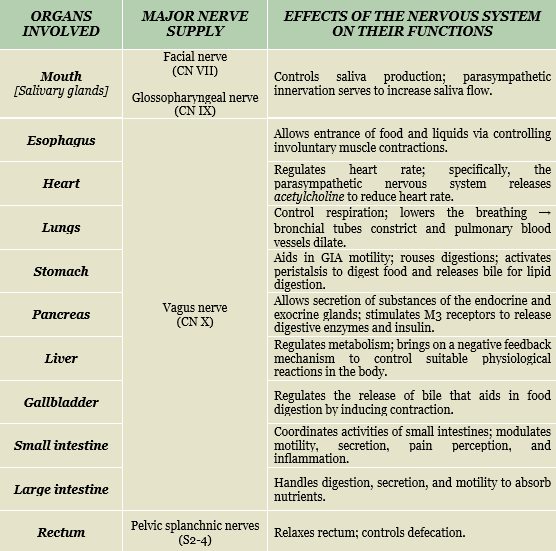Activity 3
Week 5
by GEORGETTE E. ZALDIVAR
1. You have been to an ‘eat all you can’ buffet and have consumed large amounts of food. After returning home, you recline on the couch to watch television. Which division of the nervous system will be handling your body’s after-dinner activities? List several organs involved, the major nerve supply to each organ, and the effects of the nervous system on their functions.
The nervous system division that is responsible for handling post-‘eat-all-you-can’ activities is the autonomic parasympathetic nervous system, otherwise referred to as the rest-and-digest system, which according to David Levitsky, a professor of nutrition and psychology at Cornell University, slows down your heart rate to allow you to absorb nutrition while conserving energy.
The organs involved in this process are as follows:

2. Your friend is driving home from work, listening to her favorite music, when suddenly a bicycle came out of nowhere. She manages to swerve avoiding hitting the bicycle. She continued to drive home but she noticed that her heart is beating fast, she had goose bumps, and her heads were sweaty. How would you explain these effects?
The bike coming out of nowhere could have created an accident, which is why the friend’s swerving is a form of defensive driving to avoid hitting the bicycle. The friend went from the initial calm and relaxed state of mind, as reflected by her listening to music, into a state of panic as the said events ensued. In response to these kinds of situations, the sympathetic nervous system, the body’s fight-or-flight mechanism, which is the body’s survival mechanism that ensues in response to a perceived stressful or harmful environment or situation, becomes more active, strong, and awake in reaction to challenging circumstances that put one’s life in danger.
The amygdala, a part of the brain involved in processing emotions, sends a distress signal to the hypothalamus when a stressful event occurs. The nervous system acts as a command center for this part of the brain, which communicates with the rest of the body to provide the person the strength to fight or run away.
The fast heartbeat, goosebumps, and sweaty hands are attributed to the sympathetic nervous system commanding the adrenal glands to produce cortisol and adrenalin. These hormones, along with the deliberate actions of the autonomic nerves, cause the heart to beat more quickly, the respiratory rate to rise, the blood vessels in the arms and legs to enlarge, the digestive process to change, and the blood glucose levels (sugar energy) to increase in response to the emergency.
References:
Digestive System: Function, Organs & Anatomy. (n.d.). Cleveland Clinic. Retrieved October 6, 2022, from https://my.clevelandclinic.org/health/body/7041-digestive-system
Drayer, L. (2017, February 3). Are ‘food comas’ real or a figment of your digestion? CNN. Retrieved October 6, 2022, from http://edition.cnn.com/2017/02/03/health/food-comas-drayer/index.html
Harvard Health. (2020, July 6). Understanding the stress response. Retrieved October 6, 2022, from https://www.health.harvard.edu/staying-healthy/understanding-the-stress-response
Nezami, B. G., & Srinivasan, S. (2010, August 20). Enteric Nervous System in the Small Intestine: Pathophysiology and Clinical Implications. Current Gastroenterology Reports, 12(5), 358–365. https://doi.org/10.1007/s11894-010-0129-9
Parasympathetic Nervous System (PSNS): What It Is & Function. (n.d.). Cleveland Clinic. Retrieved October 6, 2022, from https://my.clevelandclinic.org/health/body/23266-parasympathetic-nervous-system-psns
TeachMeAnatomy. (2018, December 10). The Rectum - Position - Neurovascular Supply. Retrieved October 6, 2022, from https://teachmeanatomy.info/abdomen/gi-tract/rectum/